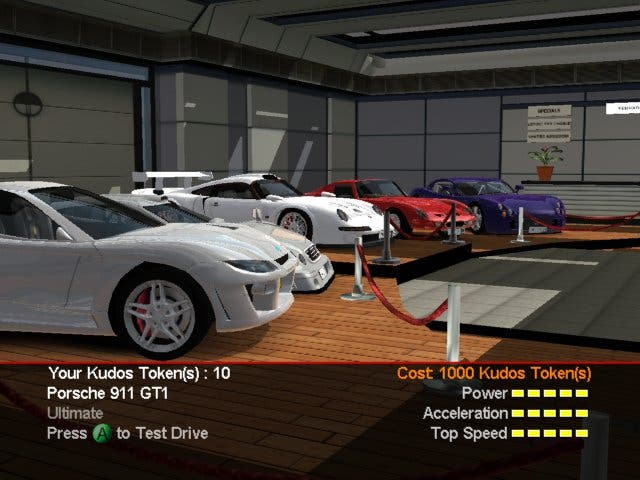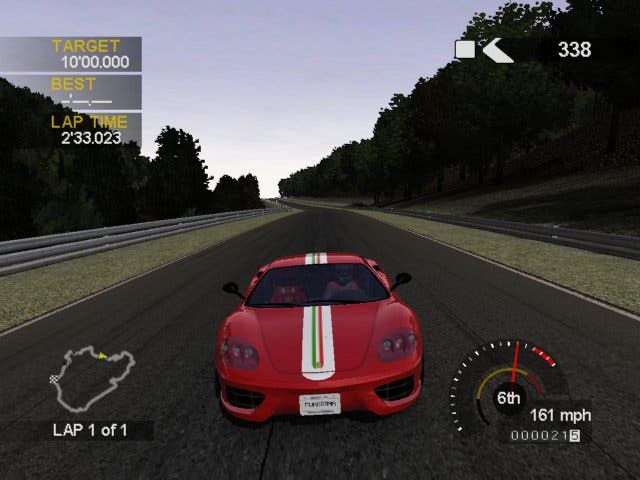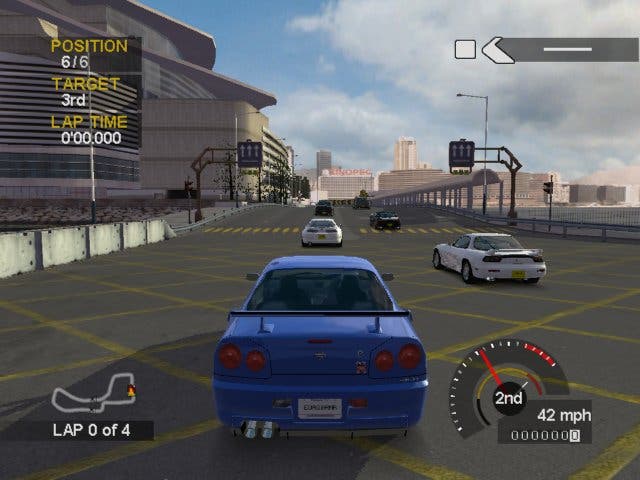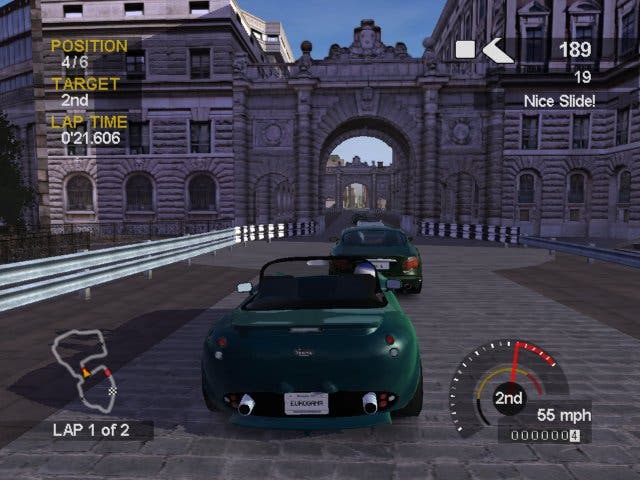Project Gotham Racing 2
Tom and Kristan fight over Bizarre Creations' latest car porn.
Although I've dabbled in Xbox Live games on numerous occasions over the past year, it wasn't until yesterday afternoon that Microsoft's online gaming service truly landed in my living room. Oddly enough, it happened during a single-player game of Project Gotham Racing 2. As I sat there happily throwing a curvy posterchild for "American muscle" into bend after bend in search of an elusive first-place finish, a little envelope-shaped icon appeared in the bottom of the screen. Eyeing it suspiciously, I finished my race, hit the A button a few times to check my score and compare it against worldwide leaderboards for that particular track, and then hit Y to pull up the game's Xbox Live menu. Sitting there at the bottom of my friends list was a request from Kristan to join him in a race - and all I had to do to switch from the cosy perfectionist pursuits of the single-player game to the heat of a six-player race over broadband was hit the A button.
You ain't got no game!

Now, when we spoke to Polyphony Digital's Kazanori Yamauchi at E3 this year, he sounded very uncertain about Gran Turismo 4's online mode. Having spent countless hours in the company of Project Gotham Racing 2, I'm hardly surprised. Yamauchi-san thinks GT4 could be limited to two-player races and even reckons that the occasional jerks and other issues that crept into the E3 build may be impossible to quash. PGR2 on the other hand delivers sumptuously detailed eight-player racing with voice communication and without a trace of lag, and is without question the finest example of an online console game to date.
Live integration runs right throughout the game. Although you can still find a Live menu with the usual Optimatch, Quick match and Content Download options, the integration here is mostly passive - downloading leaderboards for individual tracks whenever you post a new score, uploading and downloading ghost cars to watch and learn from, and of course friends list/request access via every menu screen in the game. What's more it gives you the best of both design preferences, allowing you to build up actual Kudos points and rankings via competitive multiplayer races or, if you don't want to be limited to the cars you've unlocked in the single-player game, to pick from anything that takes your fancy in a just-for-the-fun-of-it Exhibition race.
Of course we owe our passion for the Xbox Live side of things mainly to a fantastic physics model transplanted almost completely from the original Project Gotham with a few sensible tweaks. There are some real gasp-worthy moments in there, like flying off a hill only to land on the roof of an AI competitor. Individual cars are noticeably different to one another, and moving between classes is like playing different games - just try hopping into a Focus RS after a spell with the SUV races. Controls remain simple - right trigger to accelerate, left to brake, A button to handbrake - but the level of control really is unmatched, with a handling model that rewards you for taking corners properly, searching for the best line, massaging the shoulder buttons rather than mashing them and not just cynically smashing into barriers at 150mph hoping to skip off into the lead. Although the damage model is still largely superficial - though much crinklier on the bodywork than the first game - even the fastest car off the blocks is going to surrender a lead behaving like that.
In the end the racing model falls at the most addictive point between realism and Hollywood, and it's easy to pick up too thanks to tyre burns onto the track at the precise points where braking hard will give you a decent line out of a corner. Think of these are stabilisers on a bike and you'll be pulling the Gotham equivalent of wheelies and no-handers by dinnertime - abandoning them to carve out your own optimal lines and receiving even more Kudos for doing so.
Kudos for trying

Ah yes, Kudos. The other thing that keeps me playing. Kudos points, as anybody with a few minutes experience of MSR or the original Gotham well knows, are awarded by the game whenever you do something stylish - powersliding a bend, making it through a section unscathed, drafting in an opponent's wake, finding a good racing line or even taking off over the brow of a hill. Furthermore, if you can do several stylish things in a row without more than a couple of seconds elapsing between them, then the game strings your points totals together in combo - accumulating multipliers and ringing up bonuses for your efforts.
However unlike the first game, where a significant combo was entirely lost at the slightest brush of a wall (an experience equivalent to performing a multi-hundred-thousand-point combo in Tony Hawk or SSX and then accidentally landing on the wrong pixel), PGR2's Kudos combo system has been refined - now, instead of losing everything when you strike an obstacle, you only lose any points earned during that particular bit of wayward driving and the bonus points you were looking forward to banking (those shown in brackets). As a result it's still a huge disappointment to mess up a long-running combo, but it isn't the end of the world. It's a nice balance, appeasing the masses of gamers who couldn't be arsed to persevere in the face of such harshness, but also giving perfectionists like me something to sweat about.
If you dabble in the single-player game (and who would've thought 18 months ago that would ever be an 'if'?), you'll learn to treasure Kudos. Although you do earn Kudos points and improve rankings through online play, the benefits are mainly borne out on the single-player side of things, with each points milestone rewarded by Kudos tokens that can be spent unlocking new cars. And in terms of the single-player modes, Kudos is the key to progression.
Although there's plenty of fun to be had with Arcade Racing (a series of circuits spread across the game's 11 cities, which have to be conquered in small groups) and Time Attack, the bulk of your time with PGR2 will certainly be spent on the Kudos World Series tracks. These are split up between the various car classes (running through everything from family saloons, coupes and SUVs to American and Pacific muscle cars, concepts, track cars and "ultimate" dream-mobiles), which are unlocked sequentially and comprised of a number of cars to unlock and a number of driving tasks to complete using vehicles in that class.
Street smarts

As with the first game, tasks are split into various groups, some of which are old and some of which are new. This time we have Street Races (guess), Hot/Average Laps (beat a certain time with a rolling start or beat a certain average time over several laps), One on Ones (showdowns with drivers of desirable cars), Speed Cameras (tricky stretches of track culminating in a speed trap - the object being to get up as high a speed as possible for the camera), Overtake Challenges (overtake a certain number of cars within a time limit) and Cone Challenges (like PGR's "Style Challenges", but with a greater emphasis on cones - the idea being to hit an astronomical Kudos total by weaving through them and performing ludicrous slides to boot). Although the driving styles on display vary dramatically from task to task, there remains one centralising factor - you need to finish with a certain number of Kudos points to win a medal.
Each task in PGR2 basically asks you to bet against your own abilities. Although you're competing for one of five medals - Steel, Bronze, Silver, Gold and Platinum, of which the latter three are rightly dubbed Medium, Hard and Expert - you aren't just racing to try and win whichever your performance begets. In actual fact you have to pick a medal before the race and then try and perform well enough to win it. Harder medals mean progressively tougher AI, more fearsome lap time goals, higher Kudos requirements and the like, so it's a trade-off you'll want to think about - a risk/reward system that on the one hand has you grinning and mouthing "I told you so" at the furniture when you edge into Platinum territory by a fraction of a second, and on the other hand has you gouging your eyes out when you fail by a similar margin (which would have been enough to win the next medal down of course) or outdo yourself when you're only aiming for a pedestrian accolade. It's an interesting dynamic, which reeled us in with the original Gotham and continues to do so here.
However, it also seems to have been, well, dumbed down a little - you can no longer adjust the target lap time to increase or decrease your bonus reward, for example, which previously allowed more technically able drivers to get most of the Kudos they needed by driving to a higher standard, whilst also allowing flamboyant types to make up the difference in massive powerslides with a few extra seconds to get round in.
Today I become number one!

By going down this route, the game actually loses some of its finely poised balance. Although before the game was roundly accused of being too hard on occasion, this time it doesn't block progress quite so angrily when you skip over the tougher tasks. Here, in fact, you can skim through most of the game just dipping into Medium-rated challenges and basically winning them all straight off the bat. Your Kudos ranking increases at a fair enough rate on the strength of just Silver medals, meaning enough Kudos tokens to unlock the best car in any class pretty much as soon as you get there. Although it's unquestionably a lot of fun to play with some of these beastly vehicles, there's less of an emphasis on aiming higher than there was in the original PGR, even though the bar has been raised with the ludicrously difficult Platinum challenges, presumably to appease the likes of me. And with Gold/Hard tasks actually a lot tougher than Silver/Medium tasks - and not, say, just hard enough that you end up questing after them anyway - there's this tendency to romp through the single-player game without really being pushed too hard.
That said though, for me there is plenty of incentive to go back and chip away at those ridiculous totals, partly because some of the cars you can unlock only reveal their less obvious charms when you actually get them on the track, and partly thanks to the Xbox Live integration and the prospect of being crowned No.1 in the world at a particular task. Although I know Kristan is going to complain about the balance (probably because the world rankings are never going to rest in his shadow), and admittedly it isn't exactly what I was after either, it does have a lot going for it. Besides the world rankings and different cars, the tweaked reward system also means you can play PGR2 whatever mood you happen to be in - if you're a hard nut and want to be screaming at the TV all evening then you can limit yourself to racing for Gold or Platinum; if you just want to keep unlocking stuff and have some fun without the tears and profanity, then you can just race for Silver and sometimes Gold, and make steady progress; and of course you can always plug in a network cable and hop online.
Everybody's torque-ing about it

Certainly in terms of sheer volume of content PGR2 is a game that will appeal to plenty of people. Even if you are just blitzing through it on the Medium/Silver skill setting, it's going to take endless hours just to unlock all the tracks. Even playing the game using Special Reviewer Techniques (i.e. without budging from the couch for the best part of 10 hours) didn't unlock the whole game for several days, and getting all the cars into your garage, getting all the Platinum medals, winning all the Arcade Races and getting your fill of online racing is such a mammoth task that it seems harsh to criticise PGR2 for letting you do it in various ways.
In fact, the only truly unshiftable criticism on this page ought to concern the driver AI. Despite careful balancing elsewhere (whether it gels with you or not), the AI cars in PGR2 still drive without any sense of adventure, sticking to the racing line like glue, constantly barging into you because you're on their pre-determined route and often managing to ruin challenges completely by fouling up the first corner and allowing one of their number to build up an unassailable advantage while you try and dodge the spinning morons in third, fourth and fifth. Actually, it's not so much when they do this on the first corner that it grates - it's when they do it on the last stretch of a five-lap race.
Then again, even when the game was at its most punishing and frustrating, I always picked the pad up from where I'd hurled it, safe in the knowledge that I could still make progress, and fuelled by a desire to play with the next series of vehicles. Truly PGR2's cars are some of the finest ever to appear in a videogame, and deciding where to spend your Kudos tokens is quite literally like picking between Ferraris and Porsches, TVRs and Audis. There are a huge number of licensed vehicles here, and after a few hours you'll really start to drool over every acquisition, whether it's the Enzo Ferrari right at the very end to or the Vauxhall VX220 somewhere in the middle and the AC 427 Mk.III which, though I have no real idea what it is, is unquestionably my favourite car in the game thanks to the way its overpowered engine has it lurching around. Remember that bit in The Fast And The Furious where Vin Diesel reminisces about his experience with the monstrous car in his garage? "So much torque," he recalls wistfully, "the chassis twisted coming off the line" - that's the sort of feeling I got from the AC 427...
Hey there good-lookin'

Obviously the aesthetic is about half the fun, and it helps that the AC 427 is so curvy and beautiful that you lose sleep. PGR2's attention to detail in car design really seals the deal for me - the reflections in particular are just stunning, and even change dynamically as you rotate the camera for an action replay-style side-on view as you rush down a straight. The lines and curves in everything north of the SUVs are just car porn - right down to the way the brake lights on a sleek sports car sort of fade off instead of just flashing and the way scenery rolls smoothly off the bonnet of a Ferrari.
Attention to detail is exemplary throughout - right down to the way you can see the driver shifting in his seat on turns and wrenching the gearstick around. The game has obviously been carved out of a series of new cities and they each throw up different challenges - narrow flyovers here, opposing hairpins there, right-angled turns as roads follow the dirty metallic overhead railways and of course then there's the ridiculous delights of the Nurburgring. Although I've only been to Edinburgh of all the locations in the game, driving along Prince's Street and down some of the old alleys, then up into the hills was just amazingly lifelike - in fact I'd swear one of the routes is pretty close to the tour bus I went on last summer. Trackside detail is amazing of course, dwarfing the efforts of True Crime and The Getaway by emphasising every last detail, and I'm sure if you found the right angle you could even end up staring at the flowery clock.
The lighting is another marvel - we've already touched on the reflections, but there's just something magical about the way the pooled water on the tarmac catches the light, the way headlights cut through the dark, and the spot on realisation of tracks doused in grey skies and rain, which, as an Englishman, I can verify as a thoroughly accurate reflection of the glum weather parked outside my window. It has everything - right down to the way the water is spat back up like you're riding the deathtrap rollercoaster that is the M25 during a thunderstorm.
It's also worth noting that the decision to lock the game at 30fps seems to have paid dividends for the, er, capped crusader [I thought I vetoed that pun? -Ed]. The slowdown evident in our preview builds seems to have been eradicated, and as such it honestly didn't occur to me for several hours that this arguably wasn't running at full pelt.
Finishing post
With the end in sight, PGR2 feels like a success. As the sequel to one of the finest games of 2002 (and one of the best console launch titles ever made), it was always going to struggle to please everybody, and although it arguably does please everybody some of the time, it will be beaten down in some areas for failing to please some folks all of the time. But although there is still room for improvement on the AI front (and I still won't be rushing out to buy the CD sountrack), this is a vast challenge, the best reason to subscribe to Xbox Live bar none, and, if you give it a chance, it still hooks in you faster than a fishing rod mounted on an Enzo Ferrari. PGR may be better in some senses, but any racing fan who doesn't buy this one is beyond redemption.



